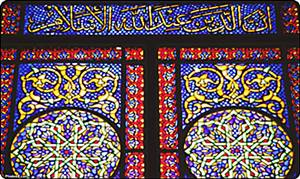Islamic Stained Glass Art
Islamic Stained Glass Art
The earliest reported Islamic use of stained glass for the beautification of buildings was in 7th century in Egypt. Modern archaeological discoveries have linked the trade of stained glass from Egypt to Vietnam within the 9th century. By contrast, in Europe the art of stained glass reached its height between 1150 and 1500, when magnificent windows were created for great cathedrals.
Some of the influences of the stained glass design centered around geometric shape, calligraphy and the Islamic floral theme as found richly in the Ottoman area.
Any artist aspires to the classical principles of harmony, unity and beauty by shaping and modifying the glass surface, painting with light to reveal multiple depths of pattern and decoration.
Examples of this can be seen in the large and the small, from the beautification of grand mosques such as those created by the Ottoman architect Mimar Sinan, in different parts of the Muslim world, to the street lamps that illuminated the Muslim towns many hundreds of years ago.




